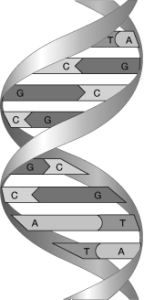Correct Answer

verified
Correct Answer
verified
Multiple Choice
Which of these statements concerning the centromere is NOT true?
A) It appears to join duplicated DNAs.
B) Its position along the chromosome varies.
C) It anchors proteins to DNA.
D) It is temporary.
E) It is the attachment site for microtubules.
G) B) and E)
Correct Answer

verified
Correct Answer
verified
Multiple Choice
In prokaryotes, the daughter cells produced by prokaryotic fission
A) can reproduce either by prokaryotic fission or by the production of gametes.
B) contain half the DNA of the original parent cell.
C) cannot replicate themselves.
D) are, with the exception of random mutations, genetically identical to the parent cell.
F) A) and B)
Correct Answer

verified
Correct Answer
verified
Multiple Choice
A cell with 10 chromosomes undergoes mitosis and cell division. How many daughter cells are produced, and what number of chromosomes do they have?
A) 2 daughter cells, 5 chromosomes each
B) 1 daughter cell, 10 chromosomes each
C) 2 daughter cells, 10 chromosomes each
D) 4 daughter cells, 20 chromosomes each
F) A) and D)
Correct Answer

verified
Correct Answer
verified
Multiple Choice
Which of the following statements is FALSE?
A) More than 1,000 chromosomes are found in some organisms.
B) The number of chromosomes remains constant throughout a life cycle.
C) The more highly evolved a species is, the more chromosomes it possesses.
D) Germ cells contain half as many chromosomes as somatic cells.
E) The number of chromosomes is the same for all members of a species.
G) A) and C)
Correct Answer

verified
Correct Answer
verified
Multiple Choice
During plant cell cytokinesis, what is the name of the structure that forms between the daughter cell nuclei and eventually will become the new cell wall?
A) Cell plate
B) Kinetochore
C) Vesicle wall
D) Constriction ring
F) C) and D)
Correct Answer

verified
Correct Answer
verified
Multiple Choice
All of the following eukaryotes can reproduce asexually EXCEPT
A) domestic dogs.
B) Hydra.
C) Amoeba.
D) aspen trees.
E) Paramecium.
G) C) and D)
Correct Answer

verified
Correct Answer
verified
Multiple Choice
Chromosomes are duplicated during what portion of the cell cycle?
A) D
B) S
C) G1
D) M
E) G2
G) A) and E)
Correct Answer

verified
Correct Answer
verified
Multiple Choice
One difference between mitotic cell division in animal cells and plant cells is that
A) plant cells do not undergo anaphase.
B) in animal cells, cytokinesis occurs as vesicles deposit carbohydrates along the equator.
C) cytokinesis occurs in animal cells but has not yet been observed in plant cells.
D) animal cells do not undergo telophase.
E) in plant cells, cytokinesis occurs as vesicles deposit carbohydrates along the equator.
G) A) and E)
Correct Answer

verified
Correct Answer
verified
Multiple Choice
Beginning with a newly formed daughter cell, what is the order of the other stages of the eukaryotic cell cycle?
A) Mitosis, G1, G2, S
B) G1, S, G2, mitosis
C) Mitosis, S, G1, G2
D) G1, G2, mitosis, S
F) None of the above
Correct Answer

verified
Correct Answer
verified
Multiple Choice
In mitosis, if a parent cell has 16 chromosomes, each daughter cell will have how many chromosomes?
A) 32
B) 8
C) 4
D) 16
E) 64
G) B) and D)
Correct Answer

verified
Correct Answer
verified
Multiple Choice
Based on this figure, the rules for nucleotide base pairing in DNA must be 
A) adenine with thymine, and guanine with cytosine.
B) adenine with thymine, and guanine with phosphate.
C) adenine with cytosine, and guanine with thymine.
D) adenine with guanine, and cytosine with thymine.
F) C) and D)
Correct Answer

verified
Correct Answer
verified
True/False
Most prokaryotes reproduce via a form of asexual reproduction called prokaryotic fission.
B) False
Correct Answer

verified
Correct Answer
verified
Multiple Choice
Nuclear envelopes form during which phase of mitosis?
A) Anaphase
B) Prophase
C) Metaphase
D) Telophase
F) C) and D)
Correct Answer

verified
Correct Answer
verified
Multiple Choice
During which phase of mitosis does cytokinesis occur?
A) Anaphase
B) Prophase
C) Metaphase
D) Telophase
F) C) and D)
Correct Answer

verified
Correct Answer
verified
Multiple Choice
The chromosomes are moving to opposite poles during
A) metaphase.
B) anaphase.
C) telophase.
D) interphase.
E) prophase.
G) A) and C)
Correct Answer

verified
Correct Answer
verified
Multiple Choice
When chromosomes become visible during prophase of mitosis, it is the result of
A) condensation.
B) chromatid duplication.
C) DNA synthesis.
D) uncoiling.
E) addition of proteins to the DNA.
G) B) and E)
Correct Answer

verified
Correct Answer
verified
Multiple Choice
Which phase of mitosis is a "preparatory" step involving the development of spindle microtubules?
A) Anaphase
B) Prophase
C) Metaphase
D) Telophase
F) B) and D)
Correct Answer

verified
Correct Answer
verified
Multiple Choice
Which of the following is TRUE of cell division?
A) Each daughter cell receives half of the cytoplasm from the parent cell.
B) The hereditary information is DNA in the parent cell and RNA in the daughter cells.
C) Three daughter cells are produced from one parent cell.
D) Each daughter cell receives one- third of the hereditary information in the parent cell.
F) A) and C)
Correct Answer

verified
Correct Answer
verified
Multiple Choice
Which of the following is the correct sequence in a cyclin- Cdk pathway?
A) Growth factor -cyclin -Cdk -receptor -DNA replication
B) Growth factor -receptor -Cdk -cyclin -DNA replication
C) Growth factor -receptor -cyclin -Cdk -DNA replication
D) Receptor -cyclin -Cdk -growth factor -DNA replication
F) A) and D)
Correct Answer

verified
Correct Answer
verified
Showing 81 - 100 of 133
Related Exams